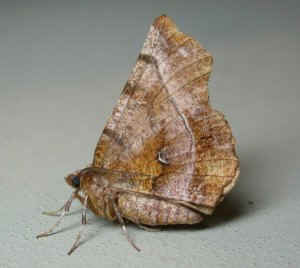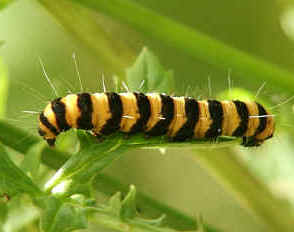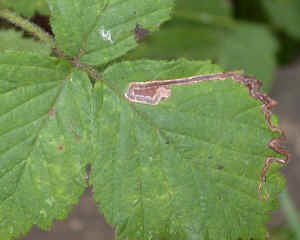Overview - Mothathon 2003
A 48 hr Moth catching
extravaganza at the Woodland Education Centre,
together with some general observations on Moths in Britain.

Seasonality Finding Moths Identifying Moths Habitats & Food Plants Geographical Variation
| The
178 different moth species recorded over the weekend of the Mothathon represent a snap
shot of the moths flying at the Woodland Education Centre on 25th and 26th July 2003. The
Centre is located near Honiton, in the county of Devon, which is in South West England.
Some of the moths trapped were Devon specialities (Devonshire Wainscot), others were
species which can be found all over the country (Common Footman), while still others were
migrants from the continent (Silver Y). The commonest moths recorded were Common Footman (188 individuals), July Highflyer (176) and Black Arches (137). These species were also recorded over the widest area (occurring in 9 or more of the 12 traps, on both nights), while other species appeared to have a more limited distribution. Privet Hawk-moth, for example, was found in only one of the traps over the weekend. The most notable species recorded were White-line Snout and Waved Carpet, which are both species considered rare enough to have National Biodiversity Action Plans devoted to them. The list compiled, while extensive, is by no means a complete list of all the species present at the Centre. |
||||
| Seasonality | ||||
| Adult
moths generally live for less than a month, with some living for only a few days. It is
instead, the caterpillar and chrysalis stages of the life cycle which take up the greater
part of a moth's total life. (This can last several years in the case of species such as
Leopard Moths.) Different moth species have widely varying life cycles and emerge as adults at different times of year. Trapping at different times of the year will therefore yield different species of moths. This is somewhat complicated by the fact that some species may have more than one generation a year. The adults can therefore be found flying at different times of year.
|
||||
| Some species will have more than two generations a year. In some
species there is no appreciable gap between the different generations. In this case, the
moths will be on the wing for an exceptionally long seasonal period. Some moth species may
have more than one generation a year in warmer southern areas where development is
quicker, but only one in colder northern regions. As many of the adult moths will only live for a few days, catches in light traps will vary widely depending on what has emerged over the last few days. Experienced moth trappers reading the list may notice that a Common Marbled Carpet was recorded. This is somewhat unexpected because late July is outside the normal flight time of the Common Marbled Carpet, although within that of the similar Dark Marbled Carpet (* flight times here). Because of the seasonal anomaly, the identification was very carefully checked and there was no doubt that the moth in question was a Common Marbled Carpet. While flight times provide guidance when identifying moths, there will always be the odd exception. For example, at other sites there have been records of a Brown-line Bright-eye moth (Mythimna conigera) in March (expected flight time, June to August) and a Large Yellow Underwing (Noctua pronuba) in April (expected flight time June/July to September). These variations in flight times may arise because of climatic differences from year to year, as well as from local differences in microclimate. In order to get a good idea of the moth species present in a particular area, you therefore need to trap all year round. However, June and July are especially good months to trap in, because this is the period when the greatest number of moth species are on the wing. To give a rough idea of seasonal differences, the National Moth Night event at the Woodland Education Centre in April, recorded 18 different species of moths (only 10% of the number of species caught in July). However, it must be noted that this only serves as an indication of seasonal differences in numbers of species. The results cannot be directly compared because a great deal more effort was put into the trapping over the Mothathon. The Mothathon results came from 12 traps set out over two nights, as opposed to three traps over only one night on National Moth Night. This will obviously affect the number of moths which are trapped. Differing weather conditions, particularly temperature, will also affect the number of moths caught. To illustrate just how variable results can be over two consecutive nights (let alone seasonally), 54 of the 146 species caught on the first night of the Mothathon, were not caught on the second night. The second night's count of 125 species, also yielded 32 species which had not been trapped on the first night. This may be because of the different weather conditions which occurred on the second night. |
||||
| Finding Moths | ||||
Weather also makes a great difference. Mild, overcast conditions are ideal. Moths will still be flying in light rain, but heavy downpours are bad both for the moth traps and for flying moths. In practice, the weather conditions will greatly affect catches, making direct comparisons difficult between different nights and even between adjacent areas with slightly different microclimates. Some moth species actually fly in the day, while others, although nocturnal, are not attracted to light. Therefore light traps, despite being a highly effective means of trapping, will not trap all of the species flying at the time. In practice, a variety of methods need to be used if a comprehensive species list is desired. Bait Many adult moths feed on nectar and so can be attracted to sugary baits. This provides an additional means of trapping different species. During the Mothathon, a heady mix of beer, brown sugar and molasses, boiled and reduced to a brown, gooey syrup, was painted on tree trunks and posts adjacent to the log cabin. These were inspected at regular intervals during the night for visiting moths. This trapping method is best when the weather is warm with a light breeze to waft the smell around. Periods of extremely wet weather (which also washes off the mix) over the Mothathon weekend means that few moths were found using this method. Wine ropes soaked in a red wine/sugar mix and hung in convenient locations are another similar way to attract additional species. Apparently, moths have a rather discerning palate and the better the wine, the more they are attracted to it! Both of these methods can be extremely effective on some occasions, but not on others. Pheromone Traps Another often highly successful method of trapping utilizes the pheromones given off by female moths. These are species-specific chemicals which disperse through the air to attract males. The male moths can detect the pheromones, sometimes over surprisingly large distances, using their antennae as sense organs. For example, male Emperor moths are said to be able to detect the female pheromones from over 5 km away. The antennae of male moths are variously feathered to increase the surface area available for receiving the scent. This readily distinguishes them from females of the same species. The pheromones of particular species can be purchased commercially and installed in traps which are hung up in a convenient location. This method is species-specific and will only attract male moths of the right species. This can be a good way to find moths which are difficult to find using other standard trapping methods. It is also extensively used to monitor population levels in individual species, particularly those considered to be pest species. Other Methods Some moths which fly in the day can be caught by sweep-netting grassy areas and similar vegetation. Searches for caterpillars and pupae can also yield records of these species.
|
||||
| The caterpillars of
some of the micro moth species are leaf miners. These tunnel in leaves, eating their way
through the leaf tissue without destroying the upper and lower surface covering of the
leaves. This creates a window-pane effect. Some of the micro moth leaf miners have very
specific food plant preferences and very distinctive, identifiable leaf mines. It can be
easier to identify the presence of a particular species from the
leaf mines, rather than from the adults. The adults of different species are sometimes
very similar in appearance, making it difficult to separate them out. .
* Common Marbled Carpet has two generations, one flying from May to June with a second between late August and early November. Dark Marbled Carpet has one generation flying in July and August. |



